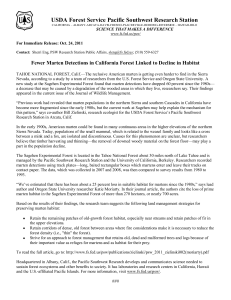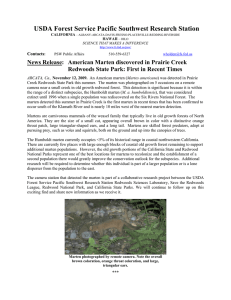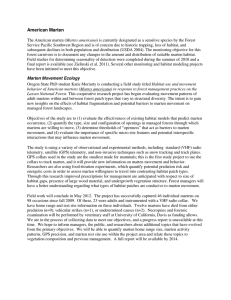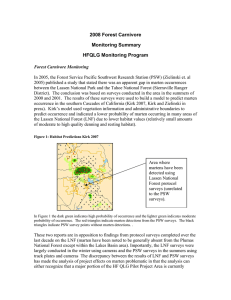2007 Wildlife Monitoring Summary Landbird and Forest Carnivore HF QLG Monitoring Program
advertisement
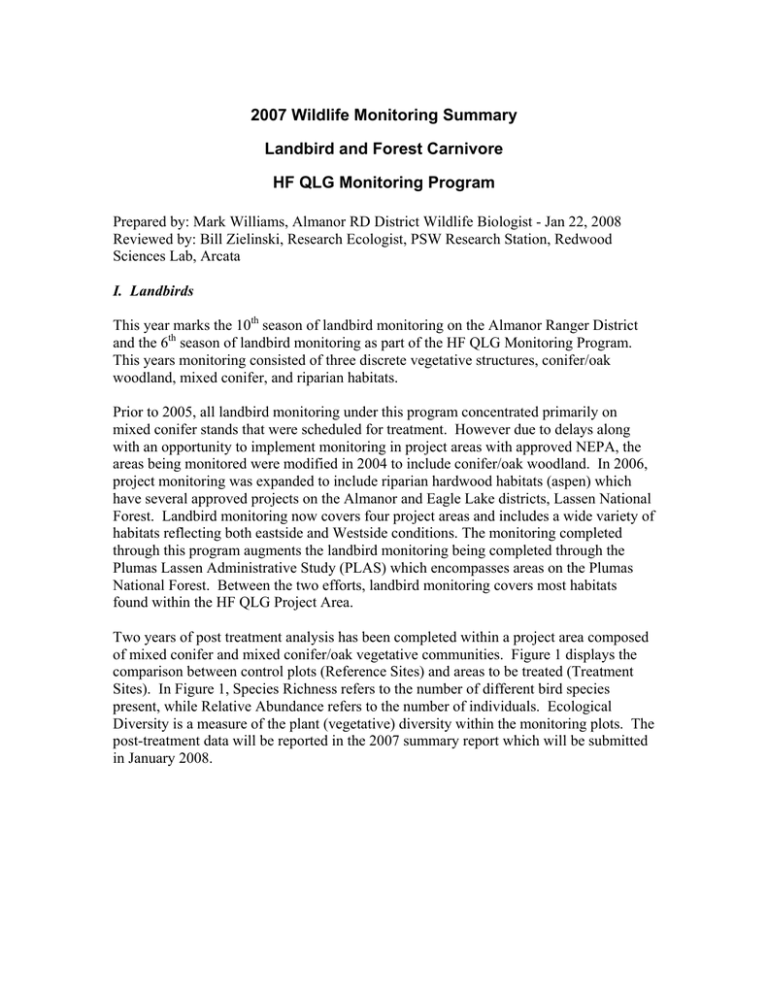
2007 Wildlife Monitoring Summary Landbird and Forest Carnivore HF QLG Monitoring Program Prepared by: Mark Williams, Almanor RD District Wildlife Biologist - Jan 22, 2008 Reviewed by: Bill Zielinski, Research Ecologist, PSW Research Station, Redwood Sciences Lab, Arcata I. Landbirds This year marks the 10th season of landbird monitoring on the Almanor Ranger District and the 6th season of landbird monitoring as part of the HF QLG Monitoring Program. This years monitoring consisted of three discrete vegetative structures, conifer/oak woodland, mixed conifer, and riparian habitats. Prior to 2005, all landbird monitoring under this program concentrated primarily on mixed conifer stands that were scheduled for treatment. However due to delays along with an opportunity to implement monitoring in project areas with approved NEPA, the areas being monitored were modified in 2004 to include conifer/oak woodland. In 2006, project monitoring was expanded to include riparian hardwood habitats (aspen) which have several approved projects on the Almanor and Eagle Lake districts, Lassen National Forest. Landbird monitoring now covers four project areas and includes a wide variety of habitats reflecting both eastside and Westside conditions. The monitoring completed through this program augments the landbird monitoring being completed through the Plumas Lassen Administrative Study (PLAS) which encompasses areas on the Plumas National Forest. Between the two efforts, landbird monitoring covers most habitats found within the HF QLG Project Area. Two years of post treatment analysis has been completed within a project area composed of mixed conifer and mixed conifer/oak vegetative communities. Figure 1 displays the comparison between control plots (Reference Sites) and areas to be treated (Treatment Sites). In Figure 1, Species Richness refers to the number of different bird species present, while Relative Abundance refers to the number of individuals. Ecological Diversity is a measure of the plant (vegetative) diversity within the monitoring plots. The post-treatment data will be reported in the 2007 summary report which will be submitted in January 2008. Figure 1: Pre-Treatment survey results of songbird status in a Mixed Conifer Oak community, Almanor Ranger District, Lassen National Forest. As discussed, riparian hardwood treatments have also been monitored pre and post treatment recording changes in landbird species diversity and richness. Figure 2 provides data from monitoring completed by PRBO on the Eagle Lake Ranger District over a 3 year period. Monitoring results for 2006 and 2007 will be reported in the 2007 summary and will show that treatment (conifer removal) within riparian areas does increase the three measures of landbird population health. Figure 2: Pre and Post Treatment survey results in aspen communities, Eagle Lake Ranger District, Lassen National Forest. The monitoring being completed on Eagle Lake shows the benefit that aspen enhancement has on woodpecker populations in particular (Figure 3). Figure 3 Mean relative abundance per point count station (<50 meters) of four woodpecker species (HAWO = Hairy Woodpecker, NOFL = Northern Flicker, RBSA = Red-breasted Sapsucker, WHWO = White-headed Woodpecker) at treated and untreated aspen sites and across over 1000survey sites in conifer habitat in the region with 95% confidence intervals, 2004 -2005. Not included in Figure 3 are the data that demonstrate pileated woodpecker, a Lassen National Forest Management Indicator Species, presence also increases following treatment. II. Forest Carnivore Research and Habitat Modeling In 2005, PSW (Zielinski et. Al 2005) published a study that stated there was an apparent gap in marten occurrences between the Lassen National Park and the Tahoe National Forest (Sierraville Ranger District). The conclusion was based on surveys conducted in the area in 2000 – 2001. A vegetative model prepared by Kirk (2007) utilized habitat as a predictor of marten occurrence and Kirks model coincided well with the earlier surveys completed by PSW. Kirks habitat model indicated a lower probability of marten occurring in many areas of the Lassen due to lower habitat values (relatively small amounts of moderate to high quality habitat). Figure 4: Habitat Predictions Kirk 2007 Area of known marten occurrence as determined through protocol surveys. In Figure 4 the dark green indicates high quality habitat and the lighter green indicates moderate quality habitat. The red triangles indicate forest carnivore (marten or fisher) detections through PSW surveys. The black triangles indicate PSW survey points. These two reports are in opposition to findings from protocol surveys completed over the last decade on the Lassen National Forest (marten have been noted to be generally absent from the Plumas National Forest except within the Lakes Basin area). This discrepancy has made the analysis of project effects on marten problematic in that the analysis can either recognize that marten have been extirpated from a major portion of the HF QLG Pilot Project Area or state that the peer-reviewed article is in error and that, contrary to research, marten do in fact occupy habitat within the national forest boundary. To resolve the discrepancy an experiment was initiated in 2007 for two purposes: 1) to test the null hypothesis that there is no seasonal difference in marten detection rates and 2) a means to test the vegetative model and make refinements if necessary. The method chosen was to resurvey areas where protocol surveys found marten but habitat suitability was low under the Kirk model. The surveys are completed under a rigid study design and will be used to determine if the vegetative (habitat) model developed by Kirk (2007) is accurate. The results will help determine the status of the marten on the Lassen (territorial individuals vs. dispersing juveniles). The study design requires two seasons of surveys to determine status. Since the majority of carnivore surveys completed by the district were done in winter and the research surveys were completed in summer, differences in seasonal detections is of interest. Of equal interest is the utility of the current predictive model. Both PSW and the HF QLG Project Area would mutually benefit by carrying out monitoring that would 1) discern the current status of marten within the Pilot Project Area, 2) provide information that would refine the predictive model, and 3) address the connectivity issues as discussed in the HF QLG FEIS (1999) and the subsequent monitoring plan. The monitoring program is to be conducted in two parts. The first part includes a systematic survey of areas that marten have been recorded (to be completed in 2008) and a review and potential refinement of the predictive habitat model based on survey results. To address the seasonal variation in detections, three grids consisting of 20 camera stations each were set up across the Almanor and part of the Eagle Lake ranger districts. One grid extended from the Lassen Volcanic National Park to the town of Mineral, California. The second grid was centered around Swain Mountain, overlapping both the Almanor RD and the Eagle Lake RD, Lassen National Forest, and the third grid was centered around Humbug Summit, Almanor RD. The summer portion of the survey was completed in 2007. Marten were found in each of the 3 grids although in low numbers which has been characteristic of summer surveys and one of the reasons winter surveys are preferred. Marten were found at four of the Mineral camera stations, one of the Swain stations, and twice at one of the Humbug stations. As predicted, bear were a common feature at virtually every station and may have played a part in the results of the summer surveys. Winter surveys are scheduled to start on December 1, 2007. Once the winter results are completed the results will be analyzed and compared to the current vegetative model. The model may then be modified to reflect the findings of the study. References Burnett R.D., K.Maute, and D.Humple. 2006 Avian Monitoring in the Lassen National Forest; 2005 Annual Report. PRBO Conservation Science. Stinson Beach, CA. Kirk, T. A. 2007. Landscape-Scale Habitat Associations of the American Marten (Martes americana) in the Greater Southern Cascades Region of California. Masters Thesis. Humboldt State University. Arcata, California. USDA Forest Service. 1999. Herger Feinstein Quincy Library Group Forest Recovery Act Final Environmental Impact Statement. Pacific Southwest Region. Zielinski, W.J., R.L. Truex, F.V. Schlexer, L.A. Campbell, and C. Carroll. 2005 Historical and contemporary distributions of carnivores in forests of the Sierra Nevada, California, USA Blackwell Publishing Ltd www.blackwellpublishing.com/jbi
